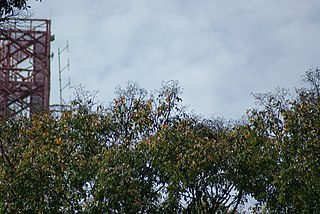
Aquilaria is a genus of fifteen species of trees, called lign aloes or lign-aloes trees, in the Thymelaeaceae, native to southeast Asia. They occur particularly in the rainforests of Indonesia, Thailand, Cambodia, Laos, Vietnam, Malaysia, Northeastern India, Bangladesh, the Philippines, Borneo and New Guinea. The trees grow to 6–20 m tall. The leaves are alternate, 5–11 cm long and 2–4 cm broad, with a short acuminate apex and an entire margin. The flowers are yellowish-green, produced in an umbel; the fruit is a woody capsule 2.5–3 cm long.

Koompassia malaccensis is a tropical rainforest tree species up to 60 m tall in the Fabaceae family. It is native to Peninsular Malaysia, Singapore, Borneo and Thailand. It is threatened by habitat loss. A common name for this wood is Kempas, it is used as a flooring material.

The streaked bulbul, or green-backed bulbul, is a songbird species in the bulbul family (Pycnonotidae). It is found on the Malay Peninsula, Sumatra, and Borneo. Its natural habitat is subtropical or tropical moist lowland forests. It is becoming rare due to habitat loss.

The short-tailed babbler is a species of bird in the family Pellorneidae.It is found in Peninsular Malaysia, Singapore, and Thailand as well as the islands of Sumatra and Borneo.

Actinodaphne malaccensis is a species of tree in the laurel family, Lauraceae. It is native to Malaysia and Singapore. It is used for timber.
Aglaia malaccensis is a species of plant in the family Meliaceae. It is found in Indonesia, Malaysia, and the Philippines.

Aquilaria malaccensis is a species of plant in the Thymelaeaceae family. It is found in Bangladesh, Bhutan, India, Indonesia, Laos, Malaysia, Myanmar, the Philippines, Singapore, and Thailand. It is threatened by habitat loss.
Burkillanthus is a monotypic genus of flowering plants in the citrus family, Rutaceae, containing the single species Burkillanthus malaccensis. It is native to Sumatra in Indonesia. It is also native to the Malay Peninsula and Sarawak in Malaysia, but it is extirpated from the peninsula and in Sarawak it was only known from a single specimen collected in 1961. Its common name is Malay ghostlime.
Lasiococca malaccensis is a species of plant in the family Euphorbiaceae. It is a tree endemic to Peninsular Malaysia.
Malaccensis may refer to:
L. malaccensis may refer to:
Madhuca malaccensis is a plant in the family Sapotaceae. It grows as a tree up to 25 metres (82 ft) tall, with a trunk diameter of up to 45 centimetres (18 in). The bark is greyish brown. Inflorescences bear up to eight flowers. The fruits are oblong, up to 2.7 centimetres (1.1 in) long. The tree is named after Malacca in Peninsular Malaysia. Habitat is lowland mixed dipterocarp forest from sea-level to 50 metres (160 ft) altitude. M. malaccensis is found in Thailand, Sumatra, Peninsular Malaysia, Singapore and Borneo.
Pouteria malaccensis is a tree in the family Sapotaceae. It grows up to 30 metres (100 ft) tall with a trunk diameter of up to 70 centimetres (30 in). The flowers are greenish-white and fragrant. The fruits are ellipsoid to roundish, up to 3.8 cm (1 in) long. The tree is named after Malacca in Peninsular Malaysia. The timber is used locally in furniture-making. Habitat is forests from sea-level to 1,400 metres (4,600 ft) altitude. P. malaccensis is found in Thailand, Sumatra, Peninsular Malaysia, Borneo, Sulawesi and New Guinea.

Sybra is a genus of beetles in the family Cerambycidae, containing the following species:

Sybra ordinata is a species of beetle in the family Cerambycidae. It was described by Bates in 1873.
Cylindrepomus malaccensis is a species of beetle in the family Cerambycidae. It was described by Stephan von Breuning in 1936.
Paranamera malaccensis is a species of beetle in the family Cerambycidae. It was described by Stephan von Breuning in 1935. It is known from Malaysia and Borneo.
Demodes malaccensis is a species of beetle in the family Cerambycidae. It was described by Stephan von Breuning in 1935.
Bluespotted stingray or blue-spotted stingray may refer to several species:
Egesina malaccensis is a species of beetle in the family Cerambycidae. It was described by Stephan von Breuning in 1938.









